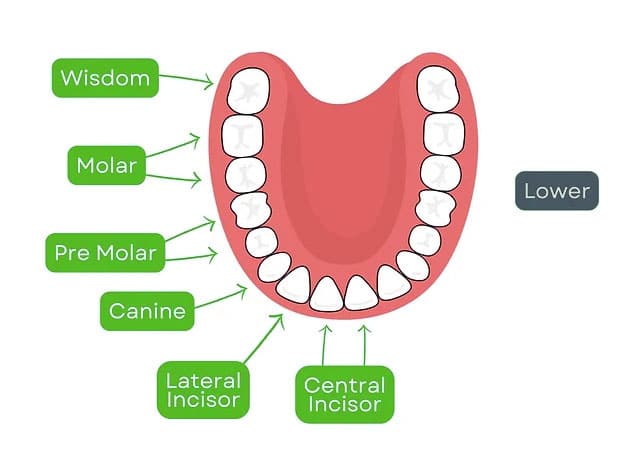Classification of Teeth | An In-Depth Overview

Table of Contents
What does the classification of teeth mean?
The classification of teeth refers to the categorization and grouping of teeth based on various characteristics such as shape, function, and location. It helps identify and understand the different types of teeth in the human dentition. Dental professionals can better describe, discuss, and refer to specific teeth when discussing oral health, treatment plans, or dental procedures by classifying teeth.
How does the dental classification of teeth work?
Teeth can be classified based on several factors, including their shape, function, and location in the mouth. It’s important to note that tooth classification may vary slightly depending on the specific dental system or classification system used by dental professionals. The classification provided here is a general overview of tooth classification based on common criteria.
Here is a more detailed classification of teeth based on these factors:
Shape
Incisors
These teeth have a sharp, chisel-shaped edge for cutting and biting food. They have a single root and a thin, flat surface. The incisors located at the front of your mouth are the most prominently visible teeth. Typically, four incisors are on the upper jaw and four on the lower jaw. This consists of the two front teeth and the adjacent teeth on each side.
Canines
Canines have a pointed tip and are designed for tearing and gripping food. They typically have a single, long root. The name “canine teeth” derives from their resemblance to the fangs of a dog. These teeth have a sharper, more pointed shape than other tooth types. Typically, individuals possess four canine teeth, one in each quadrant of the mouth (upper right, upper left, lower right, lower left).
Premolars
Premolars have a flat surface with two cusps (points) and are involved in chewing and grinding food. They generally have one or two roots. Premolars, also known as bicuspids, are situated between the canines and molars, which are the posterior teeth found at the back of your mouth.
Molars
Molars are larger and have a larger surface area with multiple cusps. They are responsible for grinding and chewing food. Molars typically have two or three roots.
Situated at the posterior region of your mouth, the molar teeth reside in the furthest position. These teeth play a vital role in chewing, accounting for approximately 90% of the chewing process. Adults typically have 12 molar teeth, with three present in each quadrant of the mouth.
Molar teeth encompass the wisdom teeth, also known as third molars. Hence, if you have undergone wisdom teeth extraction or were born without them, you will likely possess eight molar teeth.
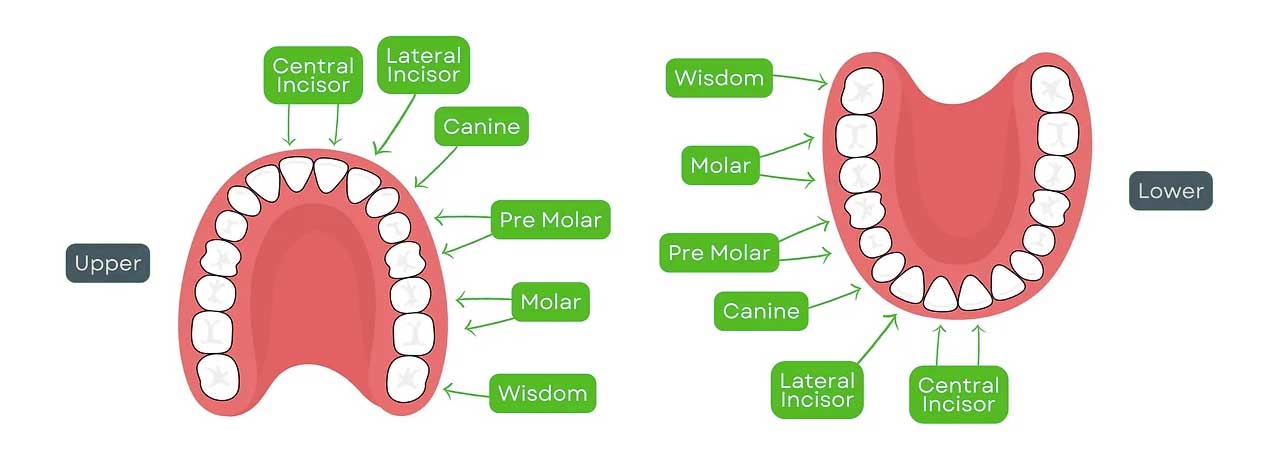
Function
Anterior Teeth
This category includes incisors and canines located in the front of the mouth. They are primarily involved in biting, cutting, and tearing food.
Posterior Teeth
This category includes premolars and molars located toward the back of the mouth. They are primarily involved in chewing and grinding food.
Location
Maxillary Teeth
These are the teeth located in the upper jaw.
Mandibular Teeth
These are the teeth located in the lower jaw.
Dental Arch
Primary Teeth
Also known as deciduous or baby teeth, they are the first set of teeth that erupt in children. There are 20 primary teeth in total.
Permanent Teeth
These are the secondary teeth that replace the primary teeth. There are 32 permanent teeth in total.
What does the classification of teeth mean?
The classification of teeth refers to the categorization and grouping of teeth based on various characteristics such as shape, function, and location. It helps identify and understand the different types of teeth in the human dentition. Dental professionals can better describe, discuss, and refer to specific teeth when discussing oral health, treatment plans, or dental procedures by classifying teeth.
How does the dental classification of teeth work?
Teeth can be classified based on several factors, including their shape, function, and location in the mouth. It’s important to note that tooth classification may vary slightly depending on the specific dental system or classification system used by dental professionals. The classification provided here is a general overview of tooth classification based on common criteria.
Here is a more detailed classification of teeth based on these factors:
Shape
Incisors
These teeth have a sharp, chisel-shaped edge for cutting and biting food. They have a single root and a thin, flat surface. The incisors located at the front of your mouth are the most prominently visible teeth. Typically, four incisors are on the upper jaw and four on the lower jaw. This consists of the two front teeth and the adjacent teeth on each side.
Canines
Canines have a pointed tip and are designed for tearing and gripping food. They typically have a single, long root. The name “canine teeth” derives from their resemblance to the fangs of a dog. These teeth have a sharper, more pointed shape than other tooth types. Typically, individuals possess four canine teeth, one in each quadrant of the mouth (upper right, upper left, lower right, lower left).
Premolars
Premolars have a flat surface with two cusps (points) and are involved in chewing and grinding food. They generally have one or two roots. Premolars, also known as bicuspids, are situated between the canines and molars, which are the posterior teeth found at the back of your mouth.
Molars
Molars are larger and have a larger surface area with multiple cusps. They are responsible for grinding and chewing food. Molars typically have two or three roots.
Situated at the posterior region of your mouth, the molar teeth reside in the furthest position. These teeth play a vital role in chewing, accounting for approximately 90% of the chewing process. Adults typically have 12 molar teeth, with three present in each quadrant of the mouth.
Molar teeth encompass the wisdom teeth, also known as third molars. Hence, if you have undergone wisdom teeth extraction or were born without them, you will likely possess eight molar teeth.
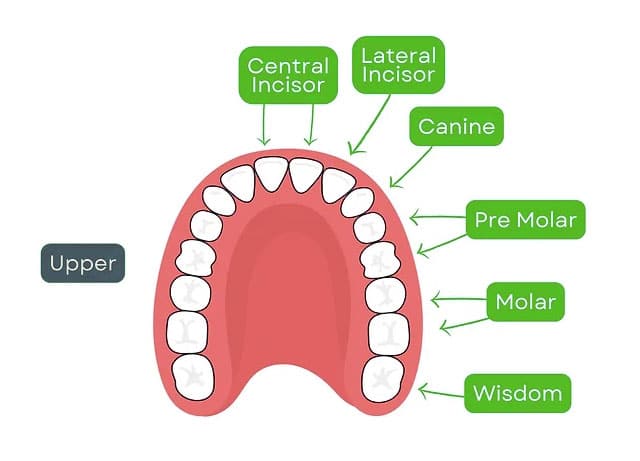
Function
Anterior Teeth
This category includes incisors and canines located in the front of the mouth. They are primarily involved in biting, cutting, and tearing food.
Posterior Teeth
This category includes premolars and molars located toward the back of the mouth. They are primarily involved in chewing and grinding food.
Location
Maxillary Teeth
These are the teeth located in the upper jaw.
Mandibular Teeth
These are the teeth located in the lower jaw.
Dental Arch
Primary Teeth
Also known as deciduous or baby teeth, they are the first set of teeth that erupt in children. There are 20 primary teeth in total.
Permanent Teeth
These are the secondary teeth that replace the primary teeth. There are 32 permanent teeth in total.
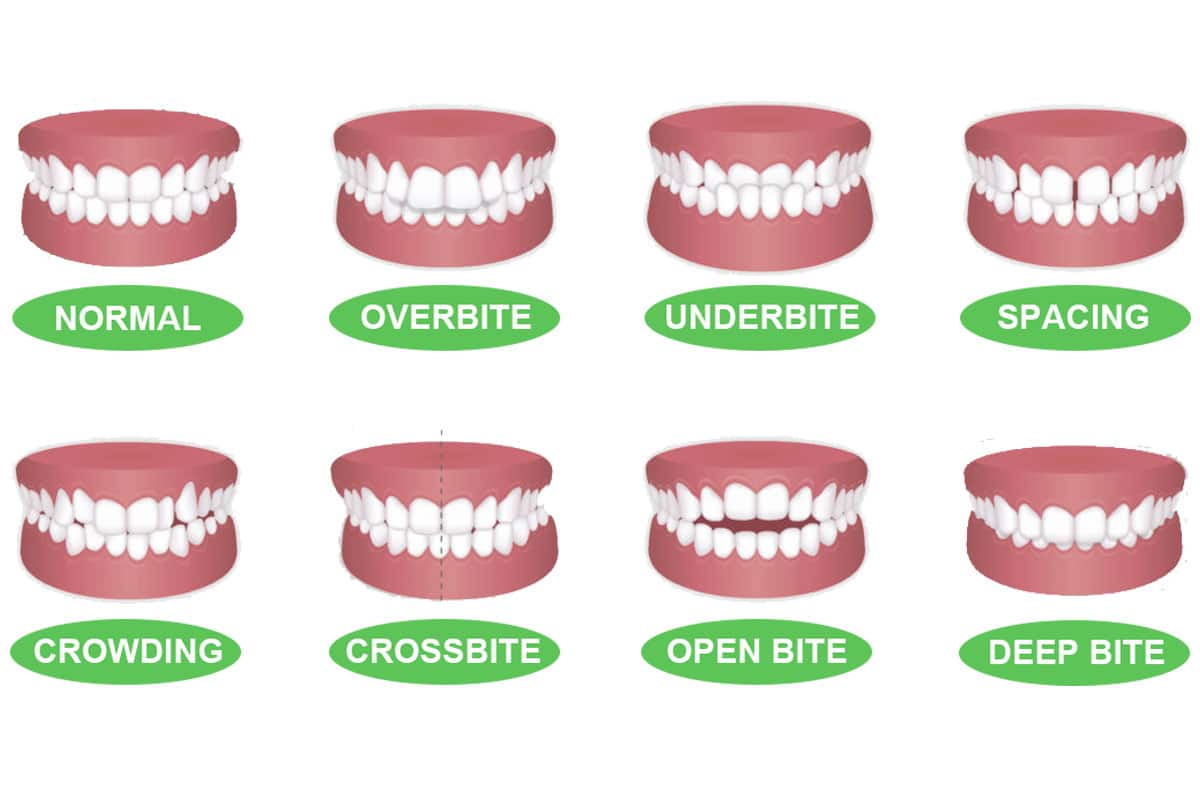
Why is tooth classification important?
Identification
Teeth can be easily identified and referred to by using a standardized classification system. It allows dentists, orthodontists, and other dental professionals to communicate effectively and accurately about specific teeth within the mouth.
Dental Treatment
Different types of teeth have different functions and characteristics, which affect treatment plans. For example, the treatment approach for a missing incisor would differ from that of a missing molar. Classification helps in determining the appropriate treatment options for each tooth type. This is especially important for the field of orthodontics.
Oral Health Evaluation
During routine dental check-ups, dentists classify teeth to assess their condition, identify abnormalities or dental issues, and plan necessary treatments. It aids in evaluating overall oral health and identifying potential problems.
Dental Education
Classification of teeth is an essential part of dental education. It provides a framework for understanding the structure and function of teeth, dental anatomy, and oral health terminology. It helps students and dental professionals learn and discuss dental concepts and procedures.
Overall, tooth classification provides a standardized system for organizing and discussing the different types of teeth in human dentition, facilitating effective communication, diagnosis, and treatment in dentistry.
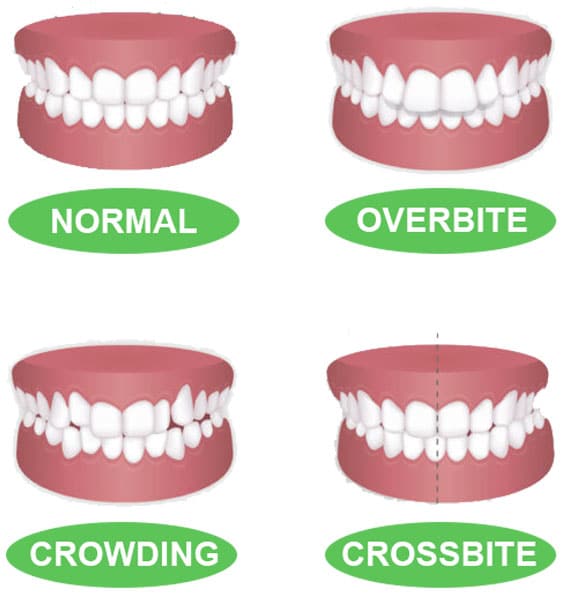
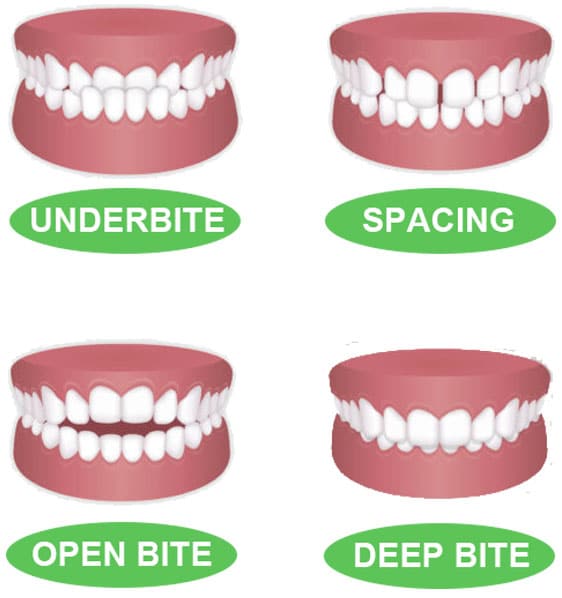
Why is tooth classification important?
Identification
Teeth can be easily identified and referred to by using a standardized classification system. It allows dentists, orthodontists, and other dental professionals to communicate effectively and accurately about specific teeth within the mouth.
Dental Treatment
Different types of teeth have different functions and characteristics, which affect treatment plans. For example, the treatment approach for a missing incisor would differ from that of a missing molar. Classification helps in determining the appropriate treatment options for each tooth type. This is especially important for the field of orthodontics.
Oral Health Evaluation
During routine dental check-ups, dentists classify teeth to assess their condition, identify abnormalities or dental issues, and plan necessary treatments. It aids in evaluating overall oral health and identifying potential problems.
Dental Education
Classification of teeth is an essential part of dental education. It provides a framework for understanding the structure and function of teeth, dental anatomy, and oral health terminology. It helps students and dental professionals learn and discuss dental concepts and procedures.
Overall, tooth classification provides a standardized system for organizing and discussing the different types of teeth in human dentition, facilitating effective communication, diagnosis, and treatment in dentistry.
Classes of teeth
Below we’ve explained the three main classes of teeth used by dental professionals to differentiate and refer to dental anatomy.
Class I teeth:
Class I teeth (Class 1 teeth) means your upper and lower teeth and jaws (or bite) have a normal relationship. No present problems or issues can be identified.

Normal
Class I Teeth

Crowding
of Class I Teeth

Improper spacing
of Class I Teeth
Class II teeth:
Class II teeth (Class 2 teeth) means your lower first molar is farther to the back of your mouth than your upper. This is an abnormal relationship; when present, the lower front teeth and jaw will not project as far forward as the upper teeth and jaw. One’s appearance will likely portray a lower lip and receding chin.
The problems for Class II teeth might stem from an overgrowth of the upper jaw, lack of lower jaw growth or even a combination of both. Most Class II problems stem from genetics, but other factors can easily enhance the problems, i.e. thumb sucking. We can treat and care for Class II teeth issues with growth redirection. This helps bring the upper and lower teeth and the jaws into the correct placement. TMD disorders often stem from Class II and Class III abnormalities.

Division 1
of Class II Teeth

Division 2
of Class II Teeth
Class III teeth:
Class III teeth (Class 3 teeth) means the lower first molar is placed closer to the front of the mouth than your upper first molar. This results in the upper teeth and jaw having less projection than the lower teeth and jaw. One might experience problems that stem from upper jaw undergrowth, lower jaw overgrowth or a combination of both. Just like Class II teeth, the problems that stem from Class III teeth can be due to genetics.

Skeleton
Class III Teeth

Dental
Class III Teeth
Classification of supernumerary teeth
Supernumerary teeth, also known as hyperdontia, exceed the normal dentition pattern. Additional teeth develop more than the usual number of teeth in the oral cavity. Supernumerary teeth can occur in both the primary (baby) dentition and the permanent dentition.
Here are a few key points about supernumerary teeth:
Types of supernumerary teeth
Supernumerary teeth can take various forms and be classified into different categories based on their shape and location. The most common types include:
Supplemental Supernumerary Teeth
These teeth resemble the normal teeth in the dentition and may appear as extra incisors, canines, premolars, or molars.
Conical Supernumerary Teeth
These teeth are smaller, peg-shaped, and often found in the anterior region of the mouth.
Tuberculate Supernumerary Teeth
These teeth have an irregular, barrel-shaped crown with multiple cusps.
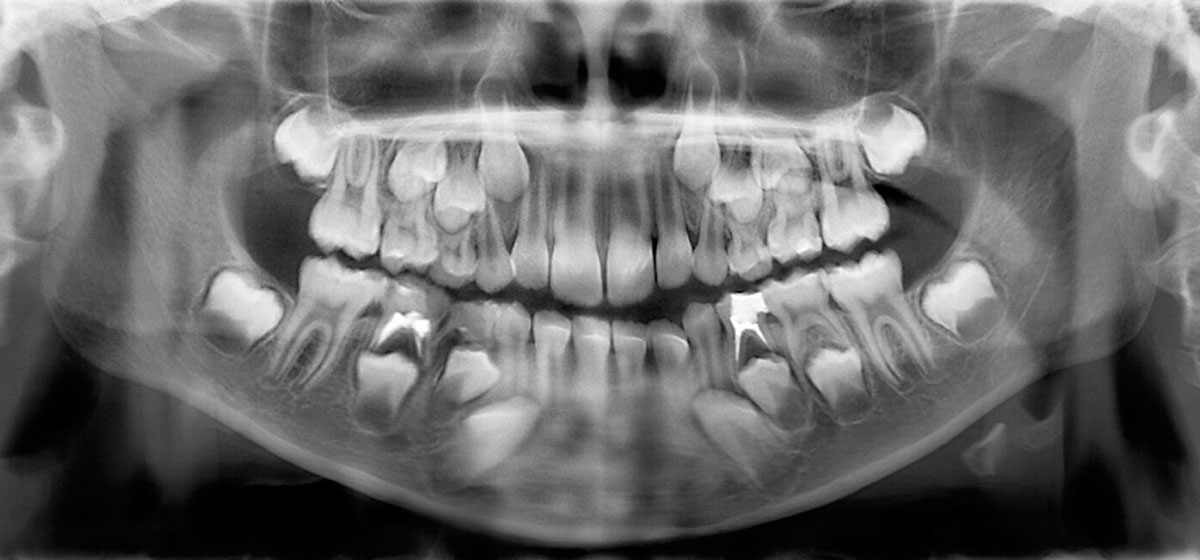
Causes
The exact cause of supernumerary teeth is not fully understood, but several factors may contribute to their development. These factors include genetic or hereditary influences, environmental factors, or disturbances during tooth development.
Prevalence
The prevalence of supernumerary teeth varies among populations but is generally estimated to be around 1-4% of the population. It is more commonly observed in males than in females.
Implications
Supernumerary teeth can have implications for oral health and dental treatment. They may cause various issues, such as overcrowding of teeth, misalignment, delayed eruption of permanent teeth, or impacted teeth. In some cases, they may be asymptomatic and require no treatment. However, if supernumerary teeth cause problems or interfere with normal dentition, they may need to be extracted or orthodontically managed.
Diagnosis and Treatment
Supernumerary teeth are typically diagnosed through dental examinations, including dental X-rays or panoramic radiographs. Treatment options depend on the specific case and may involve the extraction of supernumerary teeth, orthodontic intervention to correct alignment issues or a combination of both.
Martindale Dental provides both general and specialty dentistry under one roof. For more than 20 years, our dentists have been advocates for their patient’s oral health care needs.
Our dental offices are conveniently located throughout the GTA in Hamilton (Jackson Square), and St. Catharines, Ontario. We offer convenient appointments before or after work & on weekends.
Martindale Dental provides both general and specialty dentistry under one roof. For more than 20 years, our dentists have been advocates for their patient’s oral health care needs.
Our dental offices are conveniently located throughout the GTA in Hamilton (Jackson Square), and St. Catharines, Ontario. We offer convenient appointments before or after work & on weekends.

